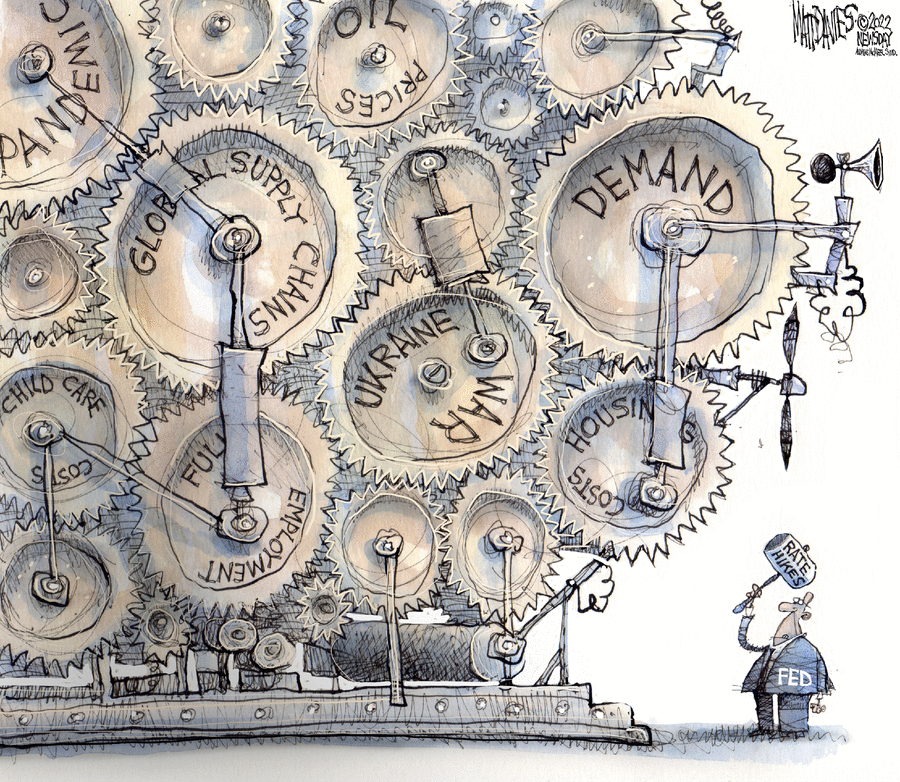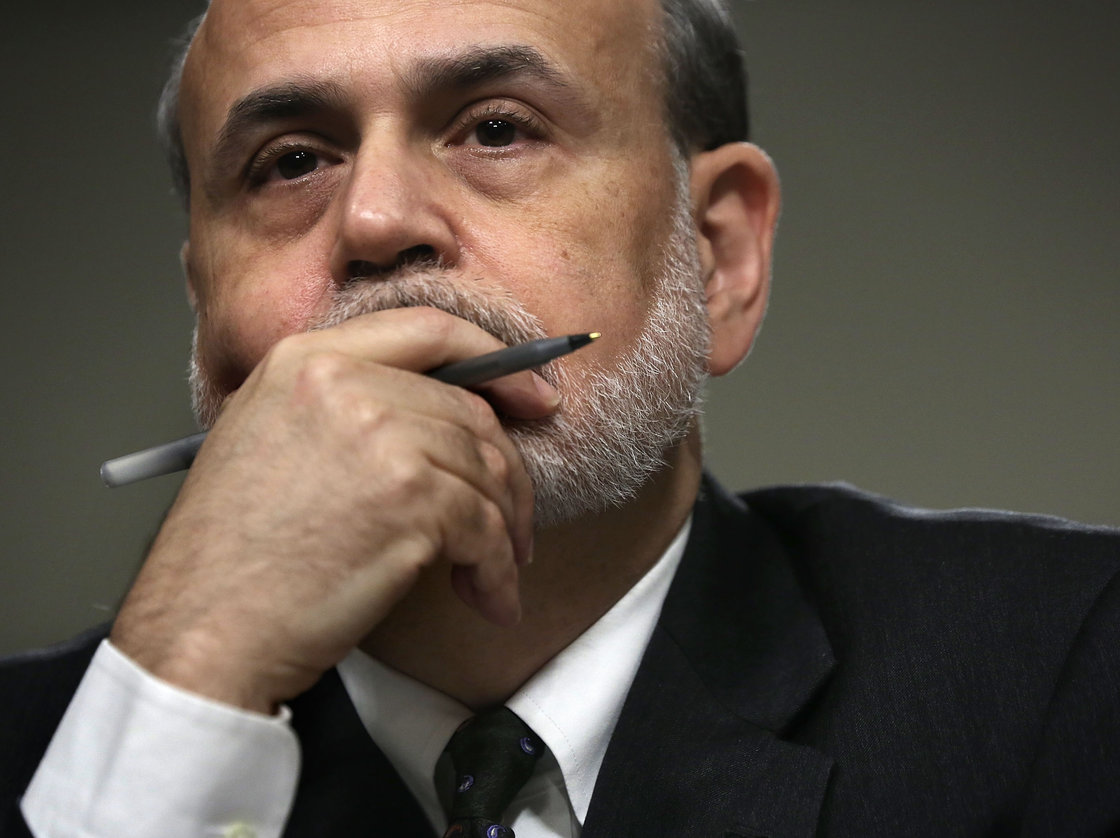|
Vocapedia >
Economy > USA > Fed > Interest rates

Matt Davies
political cartoon
GoComics
July 18, 2022
https://www.gocomics.com/mattdavies/2022/07/18
podcasts > before 2024
USA >
Federal Reserve System / The Federal Reserve / The Fed
UK / USA
https://www.federalreserve.gov/
The Federal Reserve,
through its power to
raise and lower interest rates,
exercises more influence over economic growth
and the level of employment
than
any other government entity.
That unusual role dates from the 1970s,
when the executive branch and Congress
pulled back from the use of fiscal tools
— vast New Deal spending
and targeted
tax cuts —
as a means of regulating prosperity.
http://topics.nytimes.com/top/reference/timestopics/organizations/f/
federal_reserve_system/index.html
https://www.nytimes.com/topic/organization/
federal-reserve-the-fed
2024
https://www.npr.org/2024/08/23/
nx-s1-5082386/fed-jerome-powell-lower-interest-rates
https://www.npr.org/2024/05/01/
1248454950/federal-reserve-inflation-interest-rates
https://www.npr.org/2024/03/20/
1239535703/federal-reserve-interest-interest-rates-inflation-powell-fed
2023
https://www.npr.org/2023/09/20/
1200327332/federal-reserve-inflation-economy-interest-rates
https://www.npr.org/2023/05/03/
1173371788/the-fed-raises-interest-rates-again-
in-what-could-be-its-final-attack-on-inflati
https://www.nytimes.com/2023/05/02/
business/economy/federal-reserve-interest-rates.html
2022
https://www.npr.org/2022/12/14/
1142757646/fed-federal-reserve-interest-rates-december-inflation-benchmark
https://www.npr.org/2022/09/29/
1125611533/volatility-stocks-bonds-recession-risk-fed-wall-street-bear-market-oil
https://www.npr.org/2022/09/29/
1125462240/inflation-1970s-volcker-nixon-carter-interest-rates-fed
https://www.propublica.org/article/
lev-menand-fed-unbound-interview - August 5, 2022
https://www.gocomics.com/stevebreen/2022/07/30
https://www.npr.org/2022/07/24/
1112770581/inflation-recession-soft-landing-rates-jobs-fed
https://www.gocomics.com/mattdavies/2022/07/18
https://www.npr.org/2022/06/22/
1106735608/powell-says-recession-a-possibility-but-not-likely
https://www.npr.org/2022/06/15/1
105026915/federal-reserve-interest-rates-inflation
https://www.npr.org/2022/03/16/
1086484178/the-federal-reserve-interest-rates-inflation
2021
https://www.npr.org/2021/06/16/
1007144176/federal-reserve-to-continue-supporting-economy-despite-surging-prices
https://www.propublica.org/article/
how-the-federal-reserve-is-increasing-wealth-inequality - April 27, 2021
https://www.nytimes.com/2021/02/02/
business/economy/federal-reserve-diversity.html
2020
https://www.npr.org/sections/coronavirus-live-updates/2020/03/23/
820073135/stocks-fall-even-after-the-feds-latest-move
https://www.npr.org/sections/coronavirus-live-updates/2020/03/23/
820057467/federal-reserve-unveils-extensive-new-measures-to-bolster-u-s-economy
https://www.npr.org/2020/03/16/
816382835/stocks-shudder-despite-emergency-measures
2018
https://www.npr.org/2018/08/01/
634423478/saying-economy-is-strong-fed-keeps-interest-rates-unchanged-for-now
https://www.npr.org/2018/01/31/
581649384/with-focus-on-unemployment-yellen-led-fed-through-tough-balancing-act
2017
http://www.npr.org/sections/thetwo-way/2017/06/14/
532942522/fed-raises-key-interest-rate-for-the-fourth-time-since-2015
2016
http://www.npr.org/2016/10/31/
500034877/why-the-fed-keeps-a-close-eye-on-consumer-prices
2015
http://www.npr.org/2015/12/15/
459821692/these-seven-charts-can-help-you-see-what-the-fed-is-doing
http://www.nytimes.com/2015/03/13/
business/still-reading-the-feds-tea-leaves-word-by-word.html
2013
http://economix.blogs.nytimes.com/2013/10/08/
what-the-fed-does-and-can-do/
http://www.nytimes.com/2013/09/19/
business/economy/fed-in-surprise-move-postpones-retreat-from-stimulus-campaign.html
http://www.nytimes.com/2013/01/19/
business/economy/fed-transcripts-open-a-window-on-2007-crisis.html
2011
http://www.nytimes.com/2011/12/21/
business/fed-proposes-new-capital-rules-for-banks.html
http://www.nytimes.com/2011/12/02/
opinion/the-fed-and-the-euro.html
http://www.nytimes.com/roomfordebate/2011/11/30/
did-the-fed-go-far-enough
http://www.reuters.com/article/2011/11/02/
us-usa-fed-idUSTRE7A057A20111102
2010
http://www.nytimes.com/2010/08/28/business/economy/28fed.html
http://www.nytimes.com/2010/02/25/business/economy/25fed.html
http://www.nytimes.com/2009/06/24/business/economy/24fed.html
http://www.nytimes.com/2009/03/11/business/economy/11fed.html
https://www.federalreserve.gov/newsevents/speech/
bernanke20090310a.htm
https://www.reuters.com/article/idUSTRE4AO69T
20081125
http://www.nytimes.com/2008/10/08/business/08fed.html
http://www.nytimes.com/2010/10/16/
business/economy/16fed.html
http://www.nytimes.com/reuters/2010/09/21/business/business-us-usa-fed.html
http://www.nytimes.com/2010/09/03/business/03commission.html
http://www.nytimes.com/2010/08/30/business/economy/30fed.html
http://www.nytimes.com/2010/08/28/business/economy/28fed.html
http://www.nytimes.com/2010/08/26/business/economy/26fed.html
2008
http://www.nytimes.com/2008/12/17/business/economy/17fed.html
https://www.reuters.com/article/ousiv/idUSTRE4AO4QY
20081125
http://www.nytimes.com/2008/10/30/business/economy/30fed.html
http://www.federalreserve.gov/newsevents/press/monetary/20080318a.htm
http://www.federalreserve.gov/newsevents/press/monetary/20080316a.htm
http://www.reuters.com/article/ousiv/idUSN1651144220080317
http://www.federalreserve.gov/newsevents/speech/bernanke20080314a.htm
https://www.reuters.com/article/ousiv/idUSN11554808
20080311
https://www.reuters.com/article/topNews/idUSN11557956
20080311
?virtualBrandChannel=10005
https://www.reuters.com/article/ousiv/idUSWAT009034
20080304
https://www.federalreserve.gov/newsevents/pressreleases/monetary
20080122b.htm
https://www.reuters.com/article/domesticNews/idUSWBT008460
20080227
https://www.federalreserve.gov/newsevents/testimony/bernanke20071108a.htm
http://news.bbc.co.uk/1/hi/business/6999821.stm
http://www.economist.com/daily/news/displaystory.cfm?story_id=9826026&top_story=1
http://news.bbc.co.uk/1/hi/business/6999821.stm
What the Fed Does, and Can Do
USA 2013
The Federal Reserveis a government agency
that regulates the American financial system
and, by extension, the broader economy.
Think of the financial system as an engine.
The Fed controls the availability of fuel,
basically by manipulating the price,
and it dictates the permissible uses of fuel.
It does these things with two goals in mind:
preventing the economy from growing too quickly,
and preventing the economy from shrinking.
The fuel, of course, is money.
And the Fed manipulates the price of money
by raising and lowering interest rates.
When the Fed wants
to slow down economic
activity,
it raises interest rates,
increasing the cost of borrowing money.
People and businesses borrow less and spend
less,
and growth slows down.
When the Fed wants to stimulate the economy,
it lowers interest rates.
People borrow more,
spend more — you get the
drift.
http://economix.blogs.nytimes.com/2013/10/08/
what-the-fed-does-and-can-do/
http://economix.blogs.nytimes.com/2013/10/08/
what-the-fed-does-and-can-do/
at the Fed
https://www.nytimes.com/2021/02/02/
business/economy/federal-reserve-diversity.html
Federal Reserve policymakers
http://www.npr.org/sections/thetwo-way/2017/06/14/
532942522/fed-raises-key-interest-rate-for-the-fourth-time-since-2015
keep interest
rates at a 23-year high
https://www.npr.org/2024/05/01/
1248454950/federal-reserve-inflation-interest-rates
raise interest rates
https://www.npr.org/2023/05/03/
1173371788/the-fed-raises-interest-rates-again-
in-what-could-be-its-final-attack-on-inflati
https://www.npr.org/2022/03/16/
1086484178/the-federal-reserve-interest-rates-inflation
http://www.npr.org/2017/03/15/
520223192/fed-to-announce-its-plans-for-interest-rates
raise interest
rates by 0.25 percent
http://www.npr.org/2017/03/15/
520301610/federal-reserve-raises-interest-rates-by-0-25-percent
interest rates > climb
https://www.npr.org/sections/thetwo-way/2018/02/09/
584488276/u-s-stock-market-opens-higher-after-a-tumultuous-week
interest rate hike
https://www.npr.org/2022/06/15/
1105026915/federal-reserve-interest-rates-inflation
rate hikes
https://www.gocomics.com/mattdavies/2022/07/18
lower interest
rates
https://www.npr.org/2024/08/23/
nx-s1-5082386/fed-jerome-powell-lower-interest-rates
benchmark federal funds interest rate
benchmark interest rate
http://www.npr.org/2017/06/14/
532969122/federal-reserve-raises-benchmark-interest-rate
http://www.npr.org/sections/thetwo-way/2017/06/14/
532942522/fed-raises-key-interest-rate-for-the-fourth-time-since-2015
http://www.nytimes.com/2008/12/17/
business/economy/17fed.html
Federal Reserve chairman > Jerome Powell
https://www.npr.org/2024/05/01/
1248454950/federal-reserve-inflation-interest-rates

Federal Reserve Chairman Ben Bernanke
during his Capitol Hill testimony Wednesday
before the Joint Economic Committee.
Bernanke Hints That The Economy Still Needs
Help
NPR
May 22, 2013
https://www.npr.org/sections/thetwo-way/2013/05/22/
186015232/bernanke-hints-economy-still-needs-help-home-sales-rise
The Fed Chairman / Federal Reserve Board
Chairman
Ben S. Bernanke, Federal Reserve chairman
https://www.nytimes.com/topic/person/
ben-bernanke
https://www.theguardian.com/business/
ben-bernanke
https://www.nytimes.com/2015/04/16/
business/ben-bernanke-will-work-with-citadel-a-hedge-fund-as-an-adviser.html
http://www.nytimes.com/video/2013/09/18/us/politics/100000002451327/
bernanke-on-fed-stimulus-decision.html
http://www.nytimes.com/2012/09/04/
opinion/ben-bernankes-next-task.html
http://www.nytimes.com/2011/09/03/
business/vitriol-for-bernanke-despite-the-facts.html
http://www.guardian.co.uk/business/2011/apr/28/
ben-bernanke-deficit-not-sustainable
http://www.nytimes.com/2010/10/29/
business/economy/29fed.html
http://www.nytimes.com/2010/10/16/business/economy/16fed.html
http://www.nytimes.com/2010/09/03/business/03commission.html
http://www.nytimes.com/2010/08/30/business/economy/30fed.html
http://www.nytimes.com/2010/08/28/business/economy/28fed.html
http://www.nytimes.com/2010/08/26/business/economy/26fed.html
http://www.nytimes.com/2010/01/28/opinion/28blinder.html
http://www.nytimes.com/2009/12/04/business/economy/04fed.html
http://www.nytimes.com/2009/07/27/business/27bernanke.html
https://www.reuters.com/article/ousiv/idUSTRE49J51G
20081020
https://www.reuters.com/article/ousiv/idUSTRE49J5EE
20081020
http://video.on.nytimes.com/?fr_story=a9474c5bb692d2e1735e417491d3d7b9e5c6e8f9
https://www.reuters.com/article/topNews/idUSWAT009233
20080402
https://www.federalreserve.gov/newsevents/speech/bernanke20080314
a.htm
https://www.reuters.com/article/ousiv/idUSWAT009034
20080304
https://www.reuters.com/article/domesticNews/idUSWBT008460
20080227
https://www.federalreserve.gov/newsevents/testimony/bernanke20071108
a.htm
Federal Reserve Chair > Janet Yellen
2014-2018
https://www.npr.org/2018/01/31/
581649384/with-focus-on-unemployment-yellen-led-fed-through-tough-balancing-act
Fed governor > Sherman Joseph Maisel 1918-2010
http://www.nytimes.com/2010/10/07/
business/07maisel.html
fed leaders
http://www.nytimes.com/2010/07/15/
business/economy/15econ.html
fed nominees
http://www.nytimes.com/2010/07/16/
business/economy/16fed.html
The Fed Chairman / Federal Reserve Board
Chairman
Alan Greenspan 1987 to early 2006
https://www.nytimes.com/topic/person/
alan-greenspan
http://www.nytimes.com/2008/10/24/
business/economy/24panel.html
http://www.cagle.com/news/GreenspanGoof/main.asp
Corpus of news articles
Economy > Banks > USA >
Federal Reserve / Fed
Fed Cuts Key Rate to a Record Low
December 17, 2008
The New York Times
By EDMUND L. ANDREWS
and JACKIE CALMES
WASHINGTON — The Federal Reserve entered a new era on Tuesday, lowering its
benchmark interest rate virtually to zero and declaring that it would now fight
the recession by pumping out vast amounts of money to businesses and consumers
through an expanding array of new lending programs.
Going further than expected, the central bank cut its target for the overnight
federal funds rate to a range of zero to 0.25 percent and brought the United
States to the zero-rate policies that Japan used for years in its own fight
against deflation.
Though important as a historic milestone, the move to an interest rate of zero
from 1 percent is largely symbolic. The funds rate, which affects what banks
charge for lending their reserves to each other, had already fallen to nearly
zero in recent days because banks have been so reluctant to do business.
Of much greater practical importance, the Fed bluntly announced that it would
print as much money as necessary to revive the frozen credit markets and fight
what is shaping up as the nation’s worst economic downturn since World War II.
In effect, the Fed is stepping in as a substitute for banks and other lenders
and acting more like a bank itself. “The Federal Reserve will employ all
available tools to promote the resumption of sustainable economic growth,” it
said. Those tools include buying “large quantities” of mortgage-related bonds,
longer-term Treasury bonds, corporate debt and even consumer loans.
The move came as President-elect Barack Obama summoned his economic team to a
four-hour meeting in Chicago to map out plans for an enormous economic stimulus
measure that could cost anywhere from $600 billion to $1 trillion over the next
two years.
The two huge economic stimulus programs, one from the Fed and one from the White
House and Congress, set the stage for a powerful but potentially risky
partnership between Mr. Obama and the Fed’s Republican chairman, Ben S.
Bernanke.
“We are running out of the traditional ammunition that’s used in a recession,
which is to lower interest rates,” Mr. Obama said at a news conference Tuesday.
“It is critical that the other branches of government step up, and that’s why
the economic recovery plan is so essential.”
Financial markets were electrified by the Fed action. The Dow Jones industrial
average jumped 4.2 percent, or 359.61 points, to close at 8,924.14.
Investors rushed to buy long-term Treasury bonds. Yields on 10-year Treasuries,
which have traditionally served as a guide for mortgage rates, plunged
immediately after the announcement to 2.26 percent, their lowest level in
decades, from 2.51 percent earlier in the day.
Yields on investment-grade corporate bonds edged down to 7.215 percent on
Tuesday, from 7.355 on Monday. Yields on riskier high-yielding corporate bonds
remained in the stratosphere at 22.493 percent, almost unchanged from 22.732 on
Monday.
By contrast, the dollar dropped sharply against the euro and other major
currencies for the second consecutive day — a sign that currency markets were
nervous about a flood of newly printed dollars. Some analysts predict that the
Treasury will have to sell $2 trillion worth of new securities over the next
year to finance its existing budget deficit, a new stimulus program and to
refinance about $600 billion worth of maturing government debt.
For the moment, Mr. Obama and Mr. Bernanke appear to be on the same page, though
that could abruptly change if the economy starts to revive. Fed officials have
already assumed that Congress will pass a major spending program to stimulate
the economy, and they are counting on it to contribute to economic growth next
year.
In more normal times, the Fed might easily start raising interest rates in
reaction to a huge new spending program, out of concern about rising inflation.
But data on Tuesday provided new evidence that the biggest threat to prices
right now was not inflation but deflation.
The federal government reported on Tuesday that the Consumer Price Index fell
1.7 percent in November, the steepest monthly drop since the government began
tracking prices in 1947. The decline was largely driven by the recent plunge in
energy prices, but even the so-called core inflation rate, which excludes the
volatile food and energy sectors, was essentially zero.
Mr. Obama’s goal is to have a package ready when the new Congress convenes on
Jan. 6. His hope is that the House and Senate, with their bigger Democratic
majorities, can agree quickly on a plan for Mr. Obama to sign into law soon
after he is sworn into office two weeks later.
The Fed, in a statement accompanying its rate decision, acknowledged that the
recession was more severe than officials had thought at their last meeting in
October.
“Over all, the outlook for economic activity has weakened further,” the central
bank said.
“Labor market conditions have deteriorated, and the available data indicate that
consumer spending, business investment and industrial production have declined.”
The central bank added: “The committee anticipates that weak economic conditions
are likely to warrant exceptionally low levels of the federal funds rate for
some time.”
With fewer than 10 days until Christmas, retailers from Saks Fifth Avenue to
Wal-Mart have been slashing prices to draw in consumers, who have sharply
reduced their spending over the last six months. On Tuesday, Banana Republic
offered customers $50 off on any purchases that total $125. The clothing
retailer DKNY offered customers $50 off any purchase totaling $250.
Ian Shepherdson, an analyst at High Frequency Economics, said falling energy
prices were likely to bring the year-over-year rate of inflation to below zero
in January.
The Fed has already announced or outlined a range of unorthodox new tools that
it can use to keep stimulating the economy once the federal funds rate
effectively reaches zero. On Tuesday, Fed officials said they stood ready to
expand them or create new ones to relieve bottlenecks in the credit markets.
All of the tools involve borrowing by the Fed, which amounts to printing money
in vast new quantities, a process the Fed has already started. Since September,
the Fed’s balance sheet has ballooned from about $900 billion to more than $2
trillion as it has created money and lent it out. As soon as the Fed completes
its plans to buy mortgage-backed debt and consumer debt, the balance sheet will
be up to about $3 trillion.
“At some point, and without knowing the timing, the Fed is going to have to
destroy all that money it is creating,” said Alan Blinder, a professor of
economics at Princeton and a former vice chairman of the Federal Reserve.
“Right now, the crisis is created by the huge demand by banks for hoarding cash.
The Fed is providing cash, and the banks want to hoard it. When things start
returning to normal, the banks will want to start lending it out. If that much
money is left in the monetary base, it would be extremely inflationary.”
Vikas Bajaj
contributed reporting from New York.
Fed Cuts Key Rate to a
Record Low,
NYT,
17.12.2008,
https://www.nytimes.com/2008/12/17/
business/economy/17fed.html
Explore more on these topics
Anglonautes > Vocapedia
inflation
markets , stocks, stock markets, Wall Street
economy, money, taxes,
housing market, shopping,
jobs, unemployment,
unions, retirement,
debt,
poverty, hunger,
homelessness
industry, energy, commodities
USA > White-collar / corporate crime
|